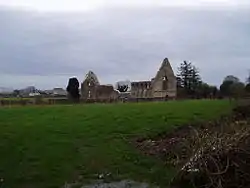Roscommon Abbey
Roscommon Abbey is a former Augustinian/Dominican Priory and National Monument located in Roscommon, Ireland.[1]
Mainistir Ros Comáin | |
 | |
 Location within Ireland | |
| Monastery information | |
|---|---|
| Other names | Ros-comain; Ros-chomon; Ros-camain; Ros-coman |
| Order | Canons Regular of Saint Augustine/Dominicans |
| Established | 1140 |
| Disestablished | 1578 |
| Diocese | Elphin |
| Architecture | |
| Status | ruined |
| Style | Norman |
| Site | |
| Location | Ballypheasan, Roscommon, County Roscommon |
| Coordinates | 53°37′29.158″N 8°11′30.487″W |
| Public access | yes |
| Official name | Roscommon Abbey |
| Reference no. | 362 |
Location
Roscommon Abbey is located in the southwest of Roscommon town.
History
Roscommon Abbey is an early monastic site, founded in the 6th century by St Comman, a disciple of Finnian of Clonard.
Roscommon Abbey was a monastery of the Augustinian Canons Regular — Arroasian founded after 1140, possibly with Arroasian reformation 1140-8 by Tairrdelbach Ua Conchobair at the instance of Saint Malachy.
Roscommon Abbey was plundered by William de Burgh in 1204 and burned by the Anglo-Normans in 1235 and 1247.
Roscommon Abbey was a Dominican priory founded in 1253 by Fedlim Ó Conchobair, king of Connacht. It was plundered by Mac William de Burgo 1260. It was hit by fire in 1270 and lightning in 1308.[2]
Roscommon Abbey was dissolved before 1578; granted to Sir Nicholas Malby in 1578 and to Francis Annesley, 1st Viscount Valentia in 1615.[3]
Building
Roscommon Friary is located in the southern part of Roscommon town, The church consisted of a single long aisle with nave and choir; the northern transept was added in the fifteenth century.
On his death in 1265 Fedlim Ó Conchobair was interred in the abbey and his tomb was covered by an effigial slab which can still be seen in a niche in the north-east corner of the church. The effigy was carved between 1290 and 1300 and is one of only two Irish royal effigies surviving from this period.[4]
References
- Gerrard, David (1 January 2004). The Hidden Places of Ireland. Travel Publishing Ltd. ISBN 9781904434108 – via Google Books.
- "Roscommon Abbey - Attractions - Churches, Abbeys and Monasteries - All Ireland - Republic Of Ireland - Roscommon - Roscommon Town - Discover Ireland".
- "Roscommon Abbey".
- CHI. "The Dominican Friary of Roscommon Town, Co. Roscommon".